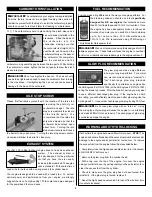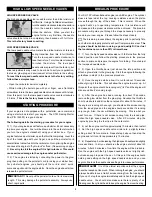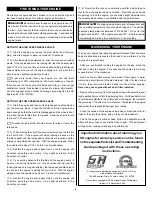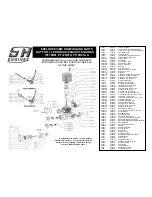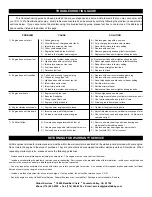
If your engine is not equipped with a pull-starter, we recommend
using a starter box to start your engine. The XTM Racing Starter
Box (P/N 146053) is a good choice.
The following details the starting procedure for your engine.
❑
1) If your engine does not feature a pull-starter, it's not necessary
to prime your engine. Fuel will be drawn into the carburetor when
you turn the engine's crankshaft, using your starter box. If your
engine features a pull-starter, open the throttle completely, cover the
tip of the tuned pipe with your finger, and pull the pull-start cord
several times to draw fuel into the carburetor. Over-priming the engine
can cause the engine to "hydro-lock" or flood. (See warning on page
2).
Never try to start the engine if it is hydro-locked. This could
cause serious damage to the engine and/or pull-starter.
❑
2) The engine is started by connecting the power to the glow
plug then pulling on the pull-start cord (or using your starter box).
For pull-start engines you should pull the cord in short, quick,
successive pulls until the engine starts. Once the engine has started,
release the pull-start cord.
✦
✦
✦
✦
✦
IMPORTANT
✦
Never pull the pull-start cord out to its maximum
length. This may damage the pull-start assembly. Always use
short, rapid pulls.
STARTING PROCEDURE
BREAK-IN PROCEDURE
Your SH .12 Pro Rear-Exhaust engine is an ABC engine. The cylinder
sleeve is tapered at the top, causing resistance when the piston
moves through the top of the stroke. This is normal. When the
engine heats up to operating temperature, this resistance will
decrease and the proper clearance will be achieved. The break-in
procedure will guide you through the steps necessary to properly
break in your new engine. Please follow the steps closely.
☞
The break-in process allows the engine parts to perfectly fit to
each other and properly protect each part from premature wear.
The
engine should be broken in using a good quality R/C car fuel
that contains no more than 20% nitromethane.
❑
1) Turn the high speed needle valve out 3 full turns from the fully
closed position and follow the starting procedure in the previous
section to prime and prepare the engine for starting. Do not adjust
the low speed needle valve.
❑
2) Open the throttle barrel just above the idle position and
attach a glow starter to the glow plug. Start the engine following the
guidelines in step 2 in the previous procedure.
❑
3) Once the engine starts, allow it to run for about 10 seconds
without giving it throttle. This will allow the engine to warm up. At
this point the engine should be running very "rich" and the engine will
also sound like it's running rough.
❑
4) After the engine has been running for about 10 seconds,
remove the glow starter from the glow plug. Advance the throttle in
short, quick bursts and drive the car around for about 2-3 minutes. If
the engine is running rich enough, you should notice smoke coming
from the tuned pipe and the engine should sound like it’s running
very rough. Also, the car will barely be moving. This is what you
want for now. If there is not smoke coming from the tuned pipe,
richen the high speed needle valve. After 2-3 minutes stop the
engine by pinching the fuel line to the carburetor.
❑
5) Let the engine cool for approximately 10 minutes, then restart
it. Set the high speed needle valve mixture to a slightly leaner
setting, about 1/8 turn more in. Repeat step 4 above, then stop the
engine and let it cool for approximately 10 minutes.
❑
6) Repeat step 5, while leaning the high speed needle valve slightly
more each time. In all, you should run the engine a total of about 45
minutes. After 45 minutes of run-time the engine will be broken in.
Run the engine with the high speed needle valve set slightly rich,
but lean enough to power the car. At this point the engine should
hold a good setting on the high speed needle valve and you can
begin to fine tune the needle valve settings to increase performance.
✦
✦
✦
✦
✦
IMPORTANT
✦
✦
✦
✦
✦
It is of the utmost importance that the engine
never be leaned out too much. When running the engine, you should
always be able to see a trail of smoke coming from the tuned pipe.
If you can’t, stop the engine immediately and richen the high speed
needle valve. You should also make sure there is plenty of air
flowing over the cylinder head to keep the engine from overheating.
3
HIGH & LOW SPEED NEEDLE VALVES
HIGH SPEED NEEDLE VALVE
The high speed needle valve is used to meter the air/fuel mixture at
full throttle. Using a flat blade screwdriver,
turn the needle clockwise to lean the mixture
or turn the needle counter-clockwise to
richen the mixture. When you start the
engine for the very first time, the needle
valve should be turned in completely, then backed out 3 full turns.
This is the factory break-in setting.
LOW SPEED NEEDLE VALVE
The low speed needle valve meters the air/fuel mixture at idle and
during transition from idle to full throttle.
Turn the low speed needle clockwise to
lean the mixture. Turn it counter-clockwise
to richen the mixture. The low speed
needle valve is preset from the factory, but
minor adjustments may need to be made to suit your application:
fuel used, glow plug and environment all contribute to the setting.
To reset the low speed needle valve back to the factory setting,
follow these simple steps:
●
Open the carburetor barrel completely.
●
While holding the barrel open with your finger, use a flat blade
screwdriver to turn the low speed needle valve clockwise until it stops.
From this point, turn the low speed needle valve counter-clockwise
2.5 turns.
This is the factory break-in setting.


